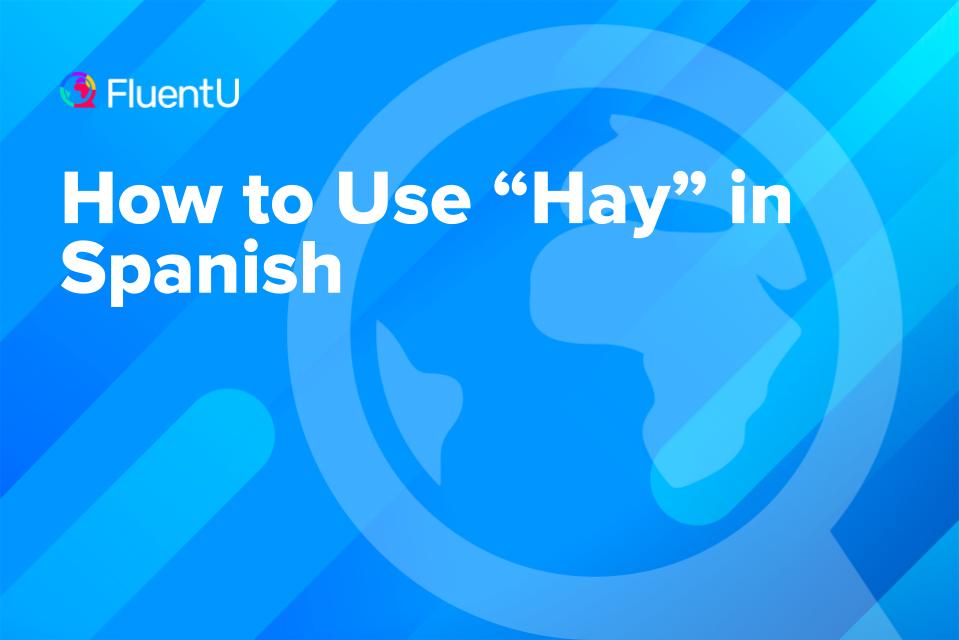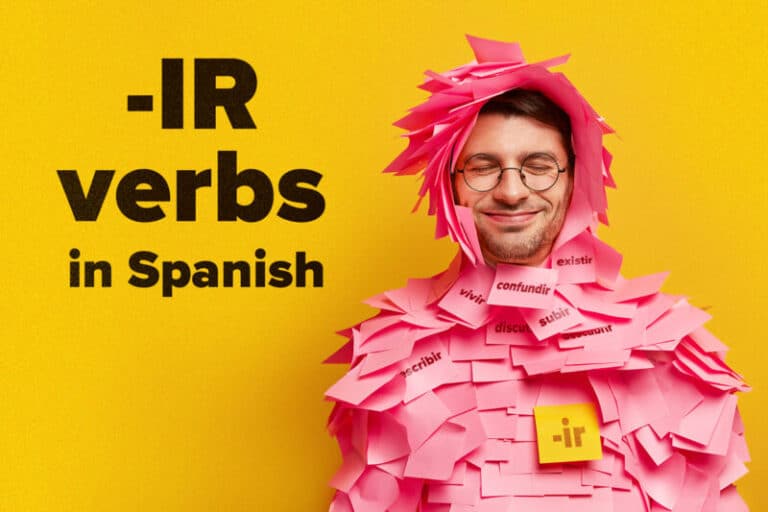How to Use “Hay” in Spanish

One of the most versatile words in Spanish is hay. This little word, derived from the verb haber, helps us talk about the existence of people, objects and even abstract concepts.
Understanding hay and how it differs from similar verbs like estar can clarify many common sentences in Spanish. Let’s have a look at how it interacts with specific words and grammar structures and help you use it confidently in any conversation.
You can also take a look at this video lesson from our YouTube channel:
Download: This blog post is available as a convenient and portable PDF that you can take anywhere. Click here to get a copy. (Download)
The Meaning and Use of the Spanish Hay
Hay Meaning “There Is”
We use hay to say that something or someone exists in some place. In other words, hay means “there is.”
For example:
Hay una llama en mi salón. (There is a llama in my living room.)
Hay un gato en mi cocina. (There is a cat in my kitchen.)
Hay una jirafa en mi baño. (There is a giraffe in my bathroom.)
Hay is the impersonal form of the verb haber (to be, to have). Since it’s impersonal, it doesn’t change, no matter the person, gender or the number we’re using in the sentence.
It can have other forms in other tenses but never changes.
For example:
Había una llama en mi salón. (There was a llama in my living room. [imperfect])
Habrá un gato en mi cocina. (There will be a cat in my kitchen. [future simple])
Hubo unas jirafas en mi baño. (There were some giraffes in my bathroom. [preterite])
Hay Meaning “There Are”
But that’s not all!
Hay also means “there are” if we’re referring to multiples of something:
Hay unas llamas en mi salón. (There are some llamas in my living room.)
Hay gatos en mi cocina. (There are [some] cats in my kitchen.)
Hay unas jirafas en mi cuarto de baño. (There are some giraffes in my bathroom.)
Hay vs. Estar
Many learners get lost when first encountering hay because they don’t understand the difference between haber and estar.
When you studied the difference between ser and estar, you learned that estar is used to say where a person or object is, like:
El niño está en el parque. (The kid is in the park.)
Los juguetes están en la caja. (The toys are in the box.)
So, if hay is used to say that something or someone exists, and estar is used to say where a person or object is, what’s the difference?
Hay = A person or object exists somewhere
When using hay, you’re just stating that a person or object exists somewhere. But when you use estar, you locate a specific person or object.
Let’s have a look at two examples:
Hay un niño en el parque. (There’s a kid in the park. [existence])
El niño está en el parque. (The kid is in the park. [location])
The first example only tells you about a kid’s existence in the park. It’s an impersonal sentence—it has no subject.
The second example tells you about the location of the kid, a specific kid and it has a subject (the kid).
If you still have problems remembering both constructions, this is what they look like when broken down into their components:
Sentences with hay: hay + person/object + (place [optional])
Sentences with estar: subject + estar + place
Let’s end this section with another couple of examples:
¿Hay zumo de naranja en la nevera? Sí hay. (Is there orange juice in the fridge? Yes, there is.)
¿Dónde está el zumo de naranja? Está en la nevera. (Where’s the orange juice? It’s in the fridge.)
Words That Trigger the Use of Hay in Spanish
Certain words give you a hint that you should use hay in your sentence.
But keep in mind that seeing these words doesn’t mean you’ll definitely also see hay.
For each trigger word or phrase below, I’ve added examples of when they lead to the use of hay and when they don’t.
1. An indefinite article
The indefinite article is your best friend when choosing between hay and estar.
This is because you cannot use hay with a definite article (like “the”), and you cannot use estar with an indefinite article (like “a” or “an”).
Un, una, unos and unas (a/one, some) are the perfect companions for hay, and you’ll see them together very often:
Hay un perro en mi jardín. (There’s a dog in my garden.)
En el parque hay una niña perdida. (There’s a lost girl in the park.)
Hay unas monedas en mi cartera. (There are some coins in my wallet.)
An example of an indefinite article not triggering hay is:
Unos hombres están preguntando por ti. (Some men are asking for you)
In the above sentence, unos hombres is the subject of the sentence. And since the sentence has a subject, we can’t use hay!
2. A plural without an article
There are times when we can use a plural form without articles.
Without the article, we’re being more general and aren’t specifying the quantity (it could be some, it could be one or it could be 500).
For example:
Hay monedas en mi cartera. (There are coins in my wallet.)
En esa bolsa hay naranjas. (There are oranges in that bag.)
Hay libros en la estantería. (There are books on the shelf.)
Here’s an example of no article/plural not triggering hay:
Vinieron personas de todo el mundo. (People from all around the world came.)
The people have an action attached to them (they came), so the sentence isn’t just stating their existence.
3. Numbers
Just as you can say there’s a kid in the park, you can say there are 25 kids in a class.
Have a look:
Hay dos perros en mi cocina. (There are two dogs in my kitchen.)
Hay cinco niños en el parque. (There are five kids in the park.)
Hay veinticinco alumnos en la clase. (There are 25 pupils in the class.)
Example of numbers not triggering hay:
Tengo cinco perros y dos gatos. (I have five dogs and two cats.)
4. Uncountable nouns
Uncountable nouns can’t be counted (what, did you expect something more profound?).
Most uncountable nouns consist of powders, liquids and abstract nouns like love, intelligence and peace.
Uncountable nouns love to appear in sentences together with hay, and the following examples are proof of that:
Hay harina en el suelo. (There’s some flour on the floor.)
¿Hay agua en la nevera? (Is there water in the fridge?)
Hay arroz pero no hay azúcar. (There’s some rice but there isn’t any sugar.)
Example of an uncountable noun not triggering hay:
Necesito harina y azúcar. (I need some flour and some sugar.)
Remember that hay indicates the existence (or lack thereof) of something! This example is expressing a need/desire, instead of mere existence.
5. Adjectives of quantity
Quantity adjectives trigger hay more often than not.
They trigger hay for the same reason numbers do: we’re talking about the number of people or objects that exist somewhere.
The four main quantity adjectives are:
1. mucho /a/os/as(a lot, many)
Hay mucha fruta en ese árbol. (There’s a lot of fruit in that tree.)
No hay mucho café. (There isn’t a lot of coffee.)
2. poco /a/os/as (few, little, a little)
Hay pocos niños en la clase. (There are few children in the classroom.)
Hay poco dinero para comprar comida. (There’s little money to buy food.)
3. bastante /s, suficiente /s (enough)
Hay bastante comida para dos personas. (There’s enough food for two people.)
Hay suficientes libros para todos. (There are enough books for everyone.)
4. demasiado /a/os/as (too much)
Hay demasiada comida aquí. (There’s too much food here.)
No hay demasiados bocadillos. (There aren’t too many sandwiches.)
Example of quantity adjectives not triggering hay:
Tenemos poco dinero pero mucho amor. (We have little money but a lot of love.)
Can you figure out by yourself why this sentence doesn’t use hay? (Hint: The English translation begins with “we have,” not “there are/is”!)
Learning how to use hay isn’t difficult if you remember the difference between haber and estar, and get to know the words that trigger hay.
Remember that hay always appears in impersonal sentences, while estar needs a subject. A program like FluentU can help you learn more about how to use each word in context, through hundreds of real-world videos.
FluentU takes authentic videos—like music videos, movie trailers, news and inspiring talks—and turns them into personalized language learning lessons.
You can try FluentU for free for 2 weeks. Check out the website or download the iOS app or Android app.
P.S. Click here to take advantage of our current sale! (Expires at the end of this month)

And now go out and cry aloud that “Hay una llama en tu salón!” (There’s a llama in your living room!).
Download: This blog post is available as a convenient and portable PDF that you can take anywhere. Click here to get a copy. (Download)
And One More Thing…
If you've made it this far that means you probably enjoy learning Spanish with engaging material and will then love FluentU.
Other sites use scripted content. FluentU uses a natural approach that helps you ease into the Spanish language and culture over time. You’ll learn Spanish as it’s actually spoken by real people.
FluentU has a wide variety of videos, as you can see here:

FluentU brings native videos within reach with interactive transcripts. You can tap on any word to look it up instantly. Every definition has examples that have been written to help you understand how the word is used. If you see an interesting word you don’t know, you can add it to a vocab list.

Review a complete interactive transcript under the Dialogue tab, and find words and phrases listed under Vocab.

Learn all the vocabulary in any video with FluentU’s robust learning engine. Swipe left or right to see more examples of the word you’re on.

The best part is that FluentU keeps track of the vocabulary that you’re learning, and gives you extra practice with difficult words. It'll even remind you when it’s time to review what you’ve learned. Every learner has a truly personalized experience, even if they’re learning with the same video.
Start using the FluentU website on your computer or tablet or, better yet, download the FluentU app from the iTunes or Google Play store. Click here to take advantage of our current sale! (Expires at the end of this month.)







